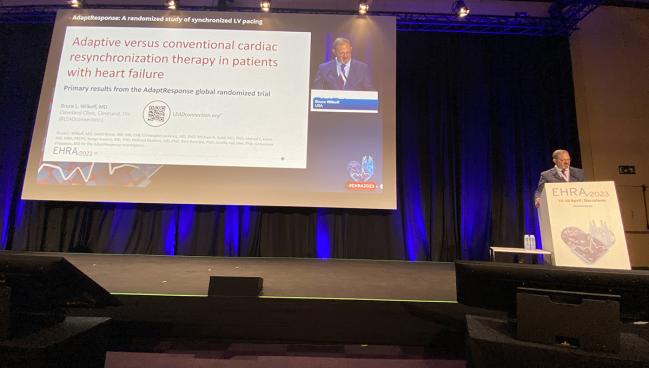Synchronized LV Pacing Not Superior to Conventional CRT in Heart Failure
The study missed its primary endpoint, but researchers still see good reason to use the dynamic LV-pacing algorithm in HFrEF.

BARCELONA, SPAIN—Cardiac resynchronization therapy (CRT) using an algorithm designed to minimize unnecessary right ventricular pacing is not superior to conventional CRT in patients with systolic heart failure (HF) and left bundle branch block (LBBB), according to results from the large, international AdaptResponse study.
The strategy of dynamic CRT—the device paces only the left ventricle (LV) when there is intact conduction to the right ventricle (RV)—did not reduce the study’s primary endpoint of all-cause mortality or heart failure events when compared with CRT with biventricular pacing. After 8 years of follow-up, the primary endpoint occurred in 33.7% of patients treated with conventional CRT and 30.8% of those treated with adaptive CRT (HR 0.89; 95 CI 0.78-1.01; P = 0.077).
Bruce Wilkoff, MD (Cleveland Clinic, OH), who presented the results during the late-breaking clinical trial session at the European Heart Rhythm Association (EHRA) 2023 congress, said they are a bit “frustrating,” noting the trial was stopped early for futility after the third interim analysis. Delays in clinical event reporting caused by the COVID-19 pandemic appeared to sway the results, however.
“Specifically, there was a delay in reporting 43 primary endpoints prior to the interim analysis,” said Wilkoff. “Had these additional endpoints been reported in a timely fashion, the stopping boundary for futility would not have been crossed.”
While the results clearly don’t show a win for adaptive CRT (AdaptivCRT; Medtronic), Wilkoff said there’s no reason not to switch on the algorithm in appropriate HF patients with LBBB. The strategy is simpler than conventional CRT programming and was associated with better battery life, including a 40% reduction in device changeout.
“There’s no reason to avoid it,” he told TCTMD.
Jan Steffel, MD (University of Zurich, Switzerland), who discussed the trial following Wilkoff’s presentation, also took a positive view of the largest randomized CRT trial to date. Missing the primary endpoint, especially in the context of the pandemic, was unfortunate, he said.
“I think it’s very important also to not make a type 2 error in the sense that we must not throw out the baby with the bathwater,” said Steffel. “There is definitely no indication of harm, and there is a good indication that this actually does work. Those [event] curves, to me, look pretty convincing.”
Focusing Specifically on LBBB Patients
Speaking with TCTMD, Wilkoff said that although CRT improves quality of life and heart failure symptoms while reducing the risk of death and hospitalizations, up to 30% of patients don’t respond to therapy.
“Cardiac resynchronization therapy, in its essence, was designed to treat people with delayed conduction to the left side of the heart,” he said. “The way that happens is with left bundle branch block. But when CRT was developed and implemented, we didn’t do so by including just patients with left bundle branch block—we said anybody with a wide QRS interval.”
In patients with intact conduction on the right side, there is no need for biventricular pacing, said Wilkoff. Pacing only the LV, while synchronizing it to intrinsic right ventricular conduction, has been suggested as a better way to improve outcomes and therapy response in heart failure patients, he explained.
What this really shows is that for patients with left bundle branch block, there really is no excuse not to use CRT, particularly adaptive CRT. Bruce Wilkoff
“If you have an intact right bundle, [extrinsic] pacing on the right side is not going to do better than that,” he said. “The right bundle is a faster, more efficient way of activating the right side of the heart.”
With the adaptive CRT algorithm, pacing is adjusted based on the patient’s conduction system, pacing only the LV during normal atrioventricular conduction and synchronizing the LV with intrinsic RV activation. The device shifts to biventricular pacing if there is prolonged or blocked AV conduction (or when heart rate is greater than 100 beats per minute).
With that background, the AdaptResponse investigators focused specifically on a HF patient population with LBBB. The study included 3,617 patients (mean age 64.9 years; 43.4% women) with LV ejection fraction ≤ 35%, NYHA class II-IV symptoms despite optimal medical therapy, and LBBB (QRS ≥ 140 ms in men and ≥ 130 ms in women). Because enrollment was closed in 2019, only a small proportion of patients were treated with an angiotensin receptor/neprilysin inhibitor and almost none were treated with an sodium-glucose cotransporter 2 (SGLT2) inhibitor.
In addition to the neutral primary endpoint, there was no significant difference in any of the secondary endpoints, including individual assessments of all-cause mortality and HF interventions for decompensation. There was also no significant difference in a clinical composite score reflective of symptoms and stability between office visits.
In a post hoc analysis, researchers assessed the primary endpoint stratified by the amount of time spent in LV pacing only. In those with ≥ 85% synchronized LV pacing, the risk of all-cause mortality/HF decompensation was significantly reduced compared with patients in the conventional CRT arm. On the other hand, those with < 85% synchronized LV pacing saw no benefit compared with conventional CRT.
Very Low Mortality Rate
Wilkoff stressed that overall mortality rates were very low, with just 16.5% of the entire study population dying at 5 years. The mortality, which varied by NYHA class, is the lowest of any randomized CRT trial to date. In addition, 93% of all patients either improved or stabilized clinically with CRT, which is the highest response rate yet reported in any randomized trial as well.
On the whole, these results suggest there is a greater overall benefit of CRT in this population than previously understood, said Wilkoff.
“What this really shows is that for patients with left bundle branch block, there really is no excuse not to use CRT, particularly adaptive CRT,” he told TCTMD. “Remember, these are sick patients and to have these very low mortality rates and heart failure hospitalization rates so many years out—this is the therapy for those type of patients.”
There is definitely no indication of harm, and there is a good indication that this actually does work. Jan Steffel
Steffel said there are a number of similar dynamic algorithms available from other manufacturers of CRT devices. These have not yet been tested in a clinical trial, although the expectation is that they’d work similarly, he said. Like Wilkoff, Steffel said the overall results show the considerable benefit of CRT in this patient population, adding that it remains underutilized in many global regions.
“On a larger scale, this [study] tells us we need to make an even bigger effort to get these patients into our hands, and into our care,” said Steffel. The EHRA, he added, recently published a statement that called for greater uptake of CRT in eligible HF patients.
“They will have benefit from a morbidity and mortality point of view,” he said. “If we have the possibility of the algorithm, use it. I don’t think there’s any reason not to.”
Michael O’Riordan is the Managing Editor for TCTMD. He completed his undergraduate degrees at Queen’s University in Kingston, ON, and…
Read Full BioSources
Wilkoff B, on behalf of the AdaptResponse investigators. Adaptive versus conventional cardiac resynchronization therapy in patients with heart failure. Presented at: EHRA 2023. April 17, 2023. Barcelona, Spain.





Comments